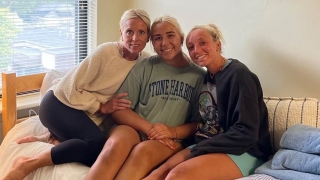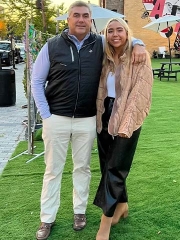Heart Transplant: Katrina’s Story
Published on
Published on
Katrina received a new heart when she was only 9 weeks old. Now, a college student at Saint Joseph’s University, Katrina is a psychology major, an aspiring child life specialist and a fierce advocate for organ donation.
 Katrina (center) with her mom (left) and sister (right).
Katrina’s heart problems were first discovered during a routine ultrasound in October 2002, five months before she was born. That was in Washington, DC.
Katrina (center) with her mom (left) and sister (right).
Katrina’s heart problems were first discovered during a routine ultrasound in October 2002, five months before she was born. That was in Washington, DC.
“We were told that the problem was serious. My doctor said we should make arrangements for care as soon as she was born at one of the country’s premier children’s hospitals,” remembers Katrina’s mom, Kati. They arranged for visits and evaluations at several hospitals and ultimately decided that CHOP was the right place for them. “I felt a connection with the team at CHOP,” says Kati.
Kati delivered at the Hospital of the University of Pennsylvania, and Katrina was immediately taken to CHOP. Today, infants like Katrina have the option of being delivered in the Garbose Family Special Delivery Unit (SDU), the world’s first birthing unit housed within a pediatric hospital that allows mom to stay close while babies are treated immediately.
For her first 48 hours, Katrina underwent an array of tests and imaging studies to get a more accurate picture of her heart problems. On day two, Kati and Jon met with the full medical team, including members of the Cardiac Center and the Transplant Center, for an update on her condition.
“They told us that Katrina had four different heart anomalies,” recalls Kati. “Any one of them could have been repaired with surgery, but because she had the combination of all four, surgery wasn’t an option. She would need a heart transplant. We thought we were prepared for everything, but we hadn’t imagined that.”
The four anomalies were total anomalous pulmonary venous return (TAOVR), double outlet right ventricle, mitral regurgitation, and pulmonary stenosis.
Just 2 days old, Katrina was put on the list for a heart transplant.
“She looked normal,” says Kati. “Her breathing was fine. Her coloring was great.” But her life was at risk until her heart could be replaced. She had a nasogastric (NG) tube so that she wouldn’t strain her heart with nursing. And she was put on antibiotics to minimize the possibility of infection, a risk made greater by another problem: Katrina had no spleen.
For her first six weeks, Katrina stayed at CHOP in the Cardiac Center. When she was released, it was with the requirement that she stay nearby, and that Kati or Jon be on call at all times and be ready to bring her into CHOP when a donor heart was identified. Fortunately, Kati’s parents lived in the area, so she moved in with them, along with her older daughter Arianna who was almost 3 years old at the time.
“Our instructions were to prepare Katrina as if she was going to the Olympics,” Kati recalls. “We were to feed her as much as we could and to keep her from getting sick.”
She would need to be at peak health when the time came for the transplant. The family followed the instructions faithfully. To avoid risk of illness, few visitors were allowed in the house. When Katrina went outdoors, it was only in a small setting. She never went into a store or into another home.
On May 17, Kati got the call. She was at a birthday party with Arianna. Katrina was at home with her grandmother. A donor heart was available. The transplant would be done that night.
Kati, Jon and her grandparents brought Katrina to CHOP. They met with Thomas Spray, MD, Chief of the Division of Cardiothoracic Surgery, and Brian Hanna, MD, Attending Cardiologist. Katrina was taken away to prepare for the procedure.
“At 2 in the morning, Jon and I were sitting in the atrium at CHOP,” Kati remembers. “We heard the sound of a helicopter approaching, then saw its lights as is passed overhead. It was the medevac arriving with Katrina’s new heart. That is a moment you can never forget.”
Early that morning, the surgeons came in and told Kati and Jon that the transplant had been successful. Katrina had been away from them for 12 hours. When Jon asked how difficult the procedure had been on a scale of 1 to 10, the surgeon told him, it had been a 10 1/2.
Katrina stayed at CHOP for 12 days after the surgery, then the family remained nearby at Kati’s parents for several weeks before returning home to Washington, DC, for the first time.
“Those first few weeks at home were hard,” says Kati. “Katrina had five rounds of medication every day, and some of them included as many as 10 different medications. It took us a while to get into the rhythm of caring for her ourselves.”
Katrina’s isolation continued for the first few weeks at home: no visitors and no exposure to strangers outside the home. Kati and Jon brought Katrina back to CHOP twice a week for the first few weeks to ensure there weren’t any complications.
Over time, the restrictions eased, and her care became simpler. The number of medications was gradually reduced and the visits to CHOP dropped back to once a month, then four times a year. She had some mild rejection issues at one year after surgery, but her medical team responded with adjustments to her medications.
“CHOP has been phenomenal about coordinating Katrina’s care,” says Kati. “It’s centralized and very focused on the family. It’s an extension of our family — a community. When we visit, the nurses ask me about each of my girls.”
“Nothing compares to CHOP — the people, the culture, the medical care and the innovation.”
 Katrina and her dad
Katrina’s heart remained stable for years, but in 2021, she began to experience graft dysfunction, or decreased function of the donor heart, which can sometimes happen after transplant, even after several years have passed. Katrina also began to experience arrhythmias.
Katrina and her dad
Katrina’s heart remained stable for years, but in 2021, she began to experience graft dysfunction, or decreased function of the donor heart, which can sometimes happen after transplant, even after several years have passed. Katrina also began to experience arrhythmias.
Maully J. Shah, MBBS, FACC, Medical Director of CHOP’s Electrophysiology and Heart Rhythm Program, implanted a defibrillator to help regulate Katrina’s heart rhythm. Two years later, she underwent a heart ablation to correct the arrhythmias by blocking irregular electrical signals and restoring a typical heartbeat. Katrina was also listed for a second transplant.
In the meantime, she continues to attend school at Saint Joseph’s University, where she is majoring in psychology with the goal of becoming a child life specialist after graduation. “My dream is to work at CHOP,” she says. “I want future patients to have the same good experience that I had.” A once year-round athlete, Katrina now enjoys walking and hiking with friends.
Katrina’s advice to young adult patients navigating a cardiac condition? “Listen to your doctors and take your medicine!” She acknowledges how hard it can be to balance schoolwork and classes with medical appointments, and she advises patients to advocate for themselves. “You have to communicate with people,” she says. “They are always understanding.”
Katrina has always been a fierce advocate for organ donation. While she acknowledges that the decision can sometimes be complicated, she emphasizes the incredible gift of life a donor can provide. “When people say ‘yes,’ a whole life becomes possible,” she says. “If it wasn’t for one family saying ‘yes,’ I wouldn’t be here. I strive to succeed for my donor. I want to keep their legacy alive.”
Originally published on Feb 21, 2017 – Updated March 2023